Several nifty reading charts are out there for keeping track of your progress as you read the standard works (for example, they used to hand one out with the seminary Scripture Mastery cards or include a chart in the manual; other charts form a picture or text). This one, however, is different because it also depicts the larger literary structure of the Book of Mormon, to help you get the big picture. Most books (the larger ones) have major and minor subdivisions. For example, 2 Nephi is subdivided into the words of Lehi (ch. 1–5), the words of Jacob (ch. 6–10), the words of Isaiah (ch. 11–30), and the words of Nephi (ch. 31–33). That third subdivision—the words of Isaiah—is further subdivided into actual quotes from Isaiah (ch. 12–24) and Nephi’s inspired commentary (ch. 25–30).
StoryGuide Scriptures Reading Chart: Book of Mormon
The subdivisions I chose are based in part on the StoryGuide Scriptures—a customized version of the standard works I have created, which lays out the (unchanged) authorized text in paragraphs and with headings, so it looks more like a modern novel or textbook. If you’re interested in reading an edition of the scriptures that uses headings to depict this chart’s subdivisions in the actual text as you read, follow the link above. You can download it for free. [Note: The Book of Mormon is not completed yet, but has some book-length sample passages.]
Explanations
The fifteen books in the Book of Mormon largely tell a single overarching story in chronological order. They can be divided into three broad sections:
- The Small Plates of Nephi (1 Nephi–Omni)
- Mormon’s Abridgment (WofM–Mormon 7)
- Moroni’s Additions (Mormon 8–Moroni)
Mormon’s abridgment is colored gold/dark yellow, of course, because it was written on the famous golden plates. I chose red for Moroni’s additions because it was completed by Mormon’s son, and red is a warm color close to gold. That, and Moroni’s additions are all about endings (like a red stop sign or stop light)—the end of the book, and the end of both the Nephites’ and Jaredites’ civilizations (like the red of fire and blood of destruction). Since the small plates of Nephi are for sacred things rather than conventional history (1 Ne. 9:4; Jacob 1:4), I considered blue (the sky; higher spiritual things) and green (living, growing things). I went with blue, mainly because I wanted to reserve green to indicate something that follows.
Some of the chapter numbers on this StoryGuide Scriptures reading chart have additional coloring that can help readers be aware of stretches of text that are a little different from the main narrative.
- Long quotations of earlier prophets are colored light green, such as the Isaiah chapters that Nephi, Abinadi, and Jesus Christ quote. This matches the use of green to indicate dialogue and spoken words of prophets in the StoryGuide edition of the standard works that I’m creating.
- Flashbacks (or, chronological digressions) are colored light yellow, such as the mission of the sons of Mosiah. This matches the yellow boxes I use in the StoryGuide Scriptures to indicate flashbacks or chronological digressions.
This is the same color scheme used in the Come Follow Me Reading Schedule for the Book of Mormon.
Closing
I did not do a chart for the Seminary selected scripture passages because the new Seminary required reading list this year is now only 9½ chapters long.
If you like this reading chart, you may also be interested in the chart showing the original chapter breaks in the Book of Mormon. The first edition Joseph Smith published had different chapter breaks than those we use today (far fewer, in fact). Those original breaks were very likely indicated on the gold plates themselves, so they should be considered when looking for larger structures and connections between passages.
I hoped this explanation has helped you know how to best use this chart for yourself and your family. If you have any questions or suggestions for improvement, I’m all ears; please comment below.
And since it’s always nice to see the whole volume of scripture from a bird’s-eye view, here’s a Pinterest-friendly version of the whole chart in one continuous column:
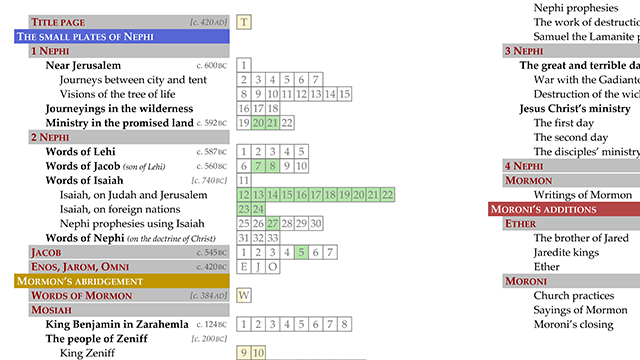
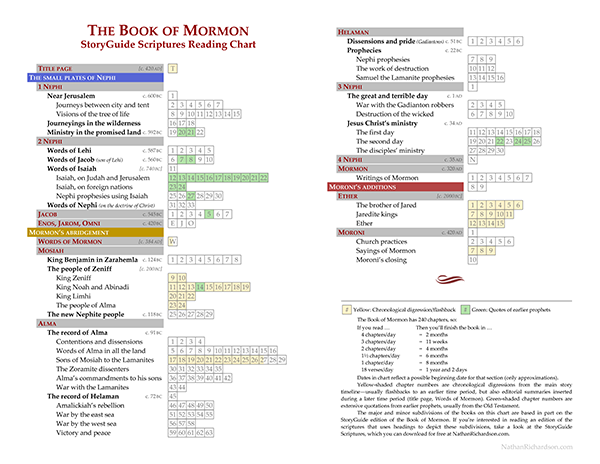

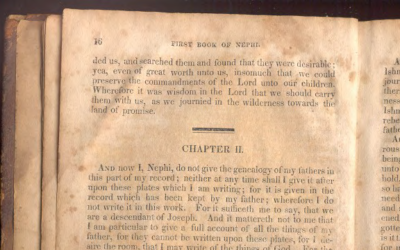
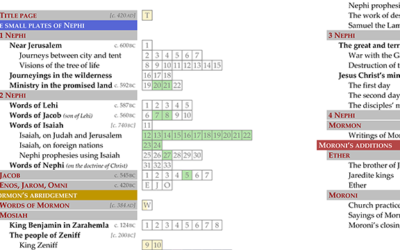
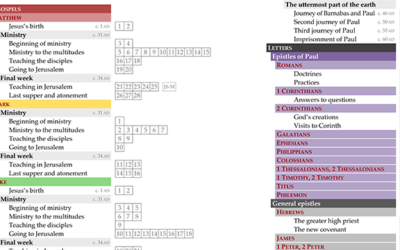
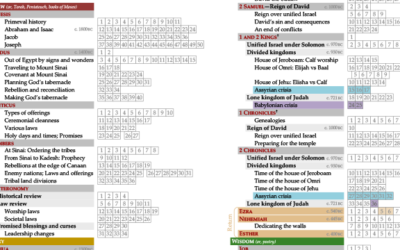
0 Comments